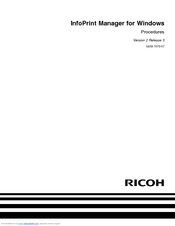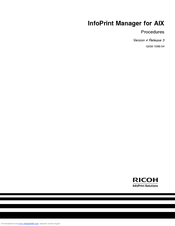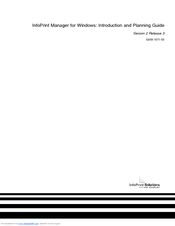Ricoh InfoPrint Pro C900AFP Manuals
Manuals and User Guides for Ricoh InfoPrint Pro C900AFP. We have 4 Ricoh InfoPrint Pro C900AFP manuals available for free PDF download: Manual, Planning Manual
Ricoh InfoPrint Pro C900AFP Manual (426 pages)
InfoPrint Manager
Table of Contents
-
Figures
11 -
Tables
13 -
-
-
SNMP Support67
-
-
-
-
Apka2E101
-
Asciinp.C101
-
Asciinpe.C101
-
Resource Exit105
-
-
-
-
-
-
Activating Imps122
-
-
-
-
-
-
-
-
-
Netware.exe238
-
-
Color Management247
-
ICC Profiles247
-
-
-
Printers260
-
-
-
-
-
-
-
-
-
-
-
Example376
-
-
Notices
387-
Trademarks388
-
-
Glossary
391
Advertisement
Ricoh InfoPrint Pro C900AFP Manual (418 pages)
InfoPrint Manager
Table of Contents
-
-
-
Snmp Support49
-
Snmp Polling56
-
Job71
-
-
Activating Imps108
-
Manual Process161
-
-
-
-
Pcl Printing223
-
Paper Tray Chart226
-
-
-
Ricoh InfoPrint Pro C900AFP Planning Manual (98 pages)
Planning Guide
Table of Contents
-
Figures
7 -
Tables
9 -
-
-
-
Queues19
-
-
PCL Printers27
-
-
-
-
-
Notices
65-
Trademarks66
-
-
Glossary
69 -
Index
93-
Worksheet95
-
Advertisement
Ricoh InfoPrint Pro C900AFP Planning Manual (98 pages)
AIX Planning Guide
Table of Contents
-
Figures
7 -
Tables
9 -
-
-
-
Queues19
-
-
PCL Printers26
-
-
-
-
-
Notices
65



